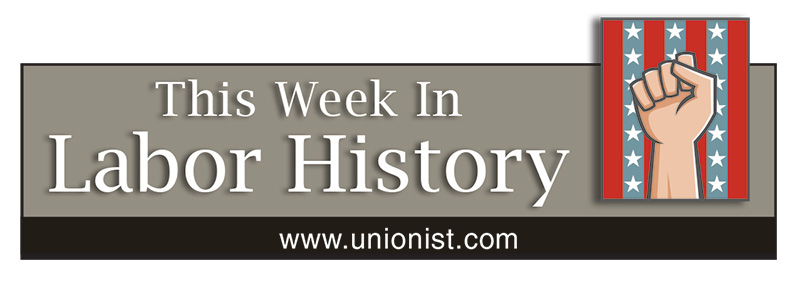
MARCH 27
1904 – Mother Jones is ordered to leave Colorado, where state authorities accuse her of “stirring up” striking coal miners.
2002 – U.S. Supreme Court rules that undocumented workers do not have the same rights as Americans when they are wrongly fired.
MARCH 28
1935 – Members of Gas House Workers’ Union Local 18799 begin what is to become a four-month recognition strike against the Laclede Gas Light Co. in St. Louis. The union later said the strike was the first ever against a public utility in the U.S.
1968 – Martin Luther King, Jr., leads a march of striking sanitation workers, members of AFSCME Local 1733, in Memphis, Tenn. Violence during the march persuades him to return the following week to Memphis, where he was assassinated.
MARCH 29
1852 – Ohio makes it illegal for children under 18 and women to work more than 10 hours a day.
1948 – “Battle of Wall Street,” police charge members of the United Financial Employees’ Union, striking against the New York Stock Exchange and New York Curb Exchange (now known as the American Stock Exchange). Forty-three workers are arrested in what was to be the first and only strike in the history of either exchange.
MARCH 30
1970 – The federal Coal Mine Health and Safety Act is enacted.
1990 – Harry Bridges, Australian-born dock union leader, dies at age 88. He helped form and lead the Int’l Longshore and Warehouse Union (ILWU) for 40 years. A Bridges quote: “The most important word in the language of the working class is ‘solidarity.’”
MARCH 31
1930 – Construction begins on the three-mile Hawk’s Nest Tunnel through Gauley Mountain, W. Va., as part of a hydroelectric project. A congressional hearing years later was to report that 476 laborers in the mostly Black, migrant workforce of 3,000 were exposed to silica rock dust in the course of their 10-hour-a-day, six-days-a-week shifts and died of silicosis. Some researchers say that more than 1,000 died.
1933 – President Franklin D. Roosevelt signs legislation establishing the Civilian Conservation Corps to help alleviate suffering during the Depression. By the time the program ended after the start of World War II it had provided jobs for more than six million men and boys. The average enrollee gained 11 pounds in his first three months.
1941 – Wisconsin state troopers fail to get scabs across the picket line to break a 76-day Allis-Chalmers strike in Milwaukee led by UAW Local 248. The plant remained closed until the government negotiated a compromise.
APRIL 1
1913 – What was to become a 13-week strike begins today in Hopedale, Mass., when hundreds of workers seeking higher pay and a nine-hour day gathered in the street near the Draper Corp. loom-making plant. The president of the company declared: “We will spend $1 million to break this strike,” and, in fact, did, aided by hundreds of sworn “special policemen” with clubs. Police were drawn from a three-state area as well.
1929 – Strike of cotton mill workers begins in Gastonia, N.C. During the strike, police raided the strikers’ tent colony; the chief of police was killed. The strike leaders were framed for murder and convicted, but later freed.
APRIL 2
1909 – The Union Label Trades Department is chartered by the American Federation of Labor. Its mission: promote the products and services produced in America by union members, especially those products identified by a union label, shop card, store card, and service button.
1923 – The Supreme Court declares unconstitutional a 1918 Washington, D.C., law establishing a minimum wage for women.
1995 – Major league baseball players end a 232-day strike, which began the prior Aug. 12 and led to the cancellation of the 1994 postseason and the World Series.
(Compiled by David Prosten, founder of Union Communication Services)

